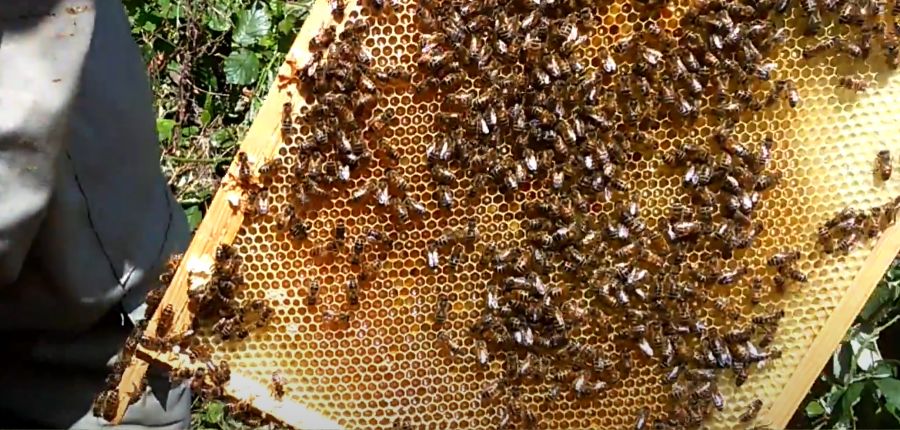A new queen bee for 2017
Posted By: John The Beekeeper Category: Riverside Bees, Wildlife(Written May 2017)
When beekeepers carry out the first hive checks of the year we always look for signs that our colonies of honeybees are ‘queen-right’ – a very apt expression which describes a colony headed by a healthy queen who is busy laying eggs. During my first inspection of the Riverside hive in April, I found lots of eggs – great! – but no sign of the queen herself, in spite of careful searching. When eggs are present, looking like tiny lengths of white thread at the base of each cell, not seeing the queen is no big deal. But even still, I like to know that the Head of the Family is alive and well. When I checked the hive a week or two later, I spotted a magnificent creature with a beautiful slender, amber coloured abdomen, strutting proudly about on a comb, much to the admiration of the worker bees surrounding her – a beautiful new queen bee! For reasons which I explain below, this was definitely not the queen who headed our colony last year.
Supersedure
Honeybees are endlessly clever creatures but in spite of much research there are still many facets of bee life that we no little, if anything, about. Exactly why a colony of bees decides to replace its queen is one such mystery. Old age, decreasing egg laying rate and injury are obvious factors, but how the collective decision is reached is still largely unknown. Supersedure normally takes place in autumn or spring and does not result in a swarm of bees leaving the hive. More on swarming in a few weeks time. When supersedure takes place and the new queen has hatched, her mother may live quite happily alongside her in the same hive for a short time until the new queen has mated and begins to lay – at which point, the old queen dies. In this way, the colony not only retains its viability, but also prepares for the busy summer season when a large workforce is needed to make lots of honey.
Marking a queen bee
So how did I know that the hive has a new queen? Like many beekeepers, I always mark my queen bees. This painless procedure involves finding the queen, then gently holding her while putting a small dot of water-based marker pen ink on her thorax. Once marked, a queen is far easier to spot among the thousands of inhabitants of the hive. There is an internationally agreed colour code for marking queen bees, five colours used on a five year cycle: white for years ending with a 1 or 6; yellow 2 or 7; red 3 or 8; green 4 or 9; and blue 5 or 0. The new Riverside queen therefore proudly displays a yellow dot and has been named Primrose as a result! Her predecessor was Bluebell, so have a guess which year she was born in.
How many eggs does a queen bee lay?
When I open the Riverside hive, I am often asked by those watching how many eggs a queen bee lays. This figure varies depending on the time of year – none during the cold winter months; a few dozen each day when warmer weather comes in early spring and the honeybee colony needs to gather strength; then a massive increase - approaching 2000 in early summer! It takes three weeks for a worker bee to develop from an egg to the day it hatches. Workers then spend a further three weeks as ‘house bees’, helping to look after the brood, keeping the hive tidy and cleaning out empty cells ready for the queen to use each one again for new eggs.
Next time you visit Riverside, do take a look at our bee hive, situated on the bank below the fence at the top of the garden centre and watch the busy bees as they come and go.







